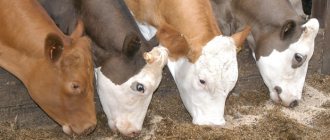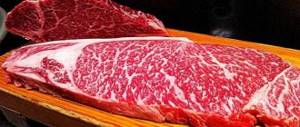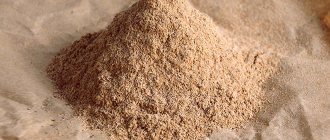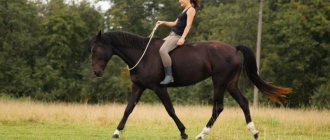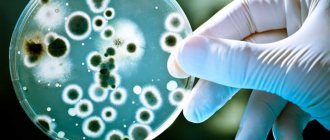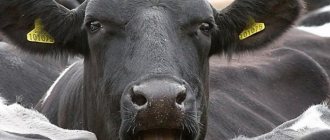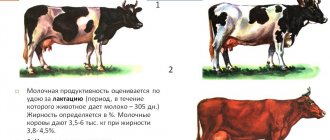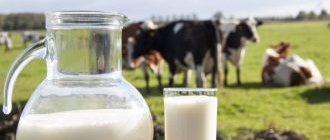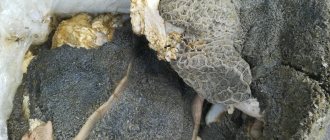What kind of disease is this
Emphysematous carbuncle or EMCAR is an acute pathology that mainly affects cattle, less commonly goats, buffaloes and sheep.
Did you know? Another name for the disease is a noisy carbuncle.
The disease is not highly contagious and is not endemic. Characteristic features include swelling (carbuncles) and lameness. The vast majority of infected animals soon die. The disease is widespread throughout the world, but vaccination and preventive measures have made it possible to avoid epidemics - infections are most often recorded in isolated cases.
Prevention of emphysematous carbuncle
Emkar is a dangerous disease of cattle caused by anaerobic bacteria. It manifests itself as damage to the joints, muscles, and the formation of swelling on the skin. In young animals it is accompanied by a septic process and rapid death. Currently observed in the form of isolated outbreaks, but the likelihood of mass spread of the infectious process remains, therefore the disease causes great economic damage to livestock breeding.
The content of the article
Pathogen and routes of infection
The causative agent of emphysematous carbuncle is Clostridium chauvoei, an anaerobic rod from the genus Clodistria, which forms multiple spores. This microorganism is found in the feces of infected animals and is released into the environment with them. Another way of spread is the decomposition of cows and bulls that died due to the disease.
Important! The bodies of infected animals must be disposed of after death.
The spores of the pathogen can also infect soil, vegetation, manure, and swamps. In this regard, livestock often become infected in the summer and early autumn when the air is dry and hot. Hay made from grass in an infested area can also cause infestation. Clostridium chauvoei are characterized by a long lifespan (from 6 months in manure and rot to 2-3 years in dry soil) and resistance to low temperatures.
Microorganisms can die when exposed to:
- UV radiation (1 day);
- boiling (2 hours);
- autoclave (half an hour);
- formaldehyde solution (15 minutes);
- sublimate solution (10 minutes).
Forms and symptoms
The incubation period of emphysematous carbuncle ranges from 1 to 5 days. The first symptoms are noticeable in the first days of the development of the disease. Basically, EMCAR has similar symptoms, but there are several forms of the disease.
Find out what clostridiosis, dictyocaulosis, thelaziosis, cysticercosis, hypodermatosis and foot and mouth disease in cattle are.
Acute
The acute form is characterized by the following course.
- The temperature rises to 41-42 °C. Painful, dense and hot carbuncles (edematous swellings) appear in the area of the hips, sternum, neck, and other areas with developed muscle mass, in the mouth or throat, which emit a cracking sound when palpated.
- The temperature of the carbuncles drops. Lymph nodes enlarge. When localized on the hips, lameness appears; manifestations in the mouth or pharynx affect the tongue.
- The animal refuses food , becomes lethargic, stops chewing and begins to breathe frequently.
- The heart rate increases and the functioning of the cardiovascular system is disrupted.
- The temperature becomes below normal. Death occurs a few days after infection. There are known cases of prolonged course of EMCAR (up to 10 days).
Super acute
The hyperacute form occurs less frequently, has a more severe manifestation and cannot be diagnosed. The main features are:
- absence of carbuncles;
- rapid progression (up to 12 hours after infection);
- coverage predominantly of calves;
- fever;
- lack of appetite;
- oppression.
Atypical
In the atypical form, timely contact with a veterinarian leads to recovery. Manifestations of the disease in this case are minimal, including:
- general depressed state;
- muscle soreness;
- duration from 1 to 5 days.
Read more about how to treat an abscess in a cow.
Emkar is a dangerous disease of cattle
Emkar (emphysematous carbuncle) is a dangerous disease of cattle caused by anaerobic bacteria. It manifests itself as damage to the joints, muscles, and the formation of swelling on the skin. In young animals it is accompanied by a septic process and rapid death. The disease causes enormous economic damage (high mortality, long-term persistence in the external environment), so increased quarantine control measures are required. The persistence of the disease is determined by the high resistance of capsule forms (in soil for up to 35 years), concealment of the true population by the private sector, and unscrupulous work of veterinarians. The causative agent of emphysematous carbuncle belongs to the genus Clostridia. Cattle are sensitive to microorganisms; the disease is also caused in small animals, wild ungulates, buffaloes and guinea pigs. Young animals are resistant to the disease for up to 3-4 months when fed colostrum from immune cows. Pathology is rarely recorded among animals older than 4 years, which is explained by the formation of stable immunity. Meat breeds are most susceptible to the disease, especially cattle with good nutrition and developed muscles. The pathogen enters the external environment with the secretions of sick animals. Dead animals play a significant role in the preservation of emkar. This is facilitated by unscrupulous farmers who leave corpses in the pasture. Infection occurs by eating grass, water or other food contaminated with spores. It is also possible for the pathogen to penetrate through skin injuries along with insect pests. Once in the body, the pathogen spore travels through the bloodstream to the muscle, where it germinates. The most favorable conditions are formed in the body of well-fed cattle with developed muscle mass. The growth of microbes is accompanied by the destruction of surrounding tissues, blood vessels, and the formation of a focus of inflammation. The disease is characterized by a sharp manifestation of symptoms - 1-2 days after infection, fever develops (temperature rises to 41-42 degrees), lameness, and swelling. Initially, a vivid picture of local inflammation is formed in various parts of the body - warm, painful swelling, but after a few days the local temperature drops and the pain reaction becomes less pronounced. When palpating the affected area, a characteristic crunching sound is noted due to the released fibrin. The skin takes on a blue-violet hue, characteristic of hematomas. Opening the affected area is accompanied by the separation of foamy contents of a dirty color, the smell resembles rancid sunflower oil. Emphysematous carbuncle of cattle requires special prevention and elimination measures due to the high preservation of the pathogen in the external environment and the danger to animals. The rapidity of development of the pathological process makes therapeutic measures difficult. Sick animals are prescribed a course of antibiotics. To prevent the appearance of emkar, it is necessary to carry out a set of veterinary and sanitary measures. All newly received animals are kept in preventive quarantine. The main measure in the prevention of the disease is active immunization of all susceptible livestock located in disadvantaged areas. Annually, single or double (depending on the grazing period and the vaccine used) preventive vaccination of animals aged from 3 months to 4 years is carried out.
The material was prepared by specialists from the Department of Veterinary Medicine and Risk Analysis of Food Production of the Federal State Budgetary Institution “Rostov Reference Center of Rosselkhoznadzor”
Diagnostics
The symptoms of some forms of emphysematous carbuncle may be hidden or insufficient to determine an accurate diagnosis. For this reason, several methods are simultaneously used to diagnose the disease.
- Clinical picture. The farmer needs to pay attention to any unusual manifestations and changes in the behavior of the animal.
- Laboratory research. For this type of diagnosis, particles of pus, muscles, and edema are needed. Material seized up to 3 hours after death can be examined.
- Pathological picture. After death, affected cattle are burned without opening, however, in hyperacute and atypical forms, this option is suitable for diagnosis.
Pathological changes
After the death of the animal, a characteristic pathological picture is determined. The corpses of affected cattle upon autopsy are distinguished by the following changes:
- swelling under the skin and in the abdominal cavity;
- liquid foam from the nasopharynx;
- the muscles are bloody, dark red in color;
- crepitant swellings on the affected muscles, filled with ichor;
- traces of hemorrhages on mucous and serous surfaces;
- enlarged liver with dead areas;
- bloody spleen;
- blood of a dark red color, caked.
Important! To avoid contamination of the area, opening must be performed only in suitable conditions!
Treatment and quarantine
With timely diagnosis, a complete recovery of infected livestock is possible. The sick animal is isolated and comprehensively treated with antibiotics and antiseptics. The ichor from swelling is wiped with hydrogen peroxide and potassium permanganate. The carbuncles themselves are treated by injection with solutions:
- carboxylic acid (4%);
- Lysol (5%);
- manganese (0.1%);
- hydrogen peroxide (2%).
The following antibiotics are used intramuscularly for therapy:
- amoxicillin (15 mg per 1 kg, 1 time in 2 days, 2 injections);
- biomycin (3-4 mg per 1 kg, 1 time per day, 5 days);
- dibiomycin (40 thousand units per 1 kg, one-time use);
- penicillin (3-5 thousand units per 1 kg, 1 time every 6 hours, until recovery).
An important stage in therapy is quarantine. It is carried out according to the instructions.
- First, the barn is disinfected with caustic soda, formaldehyde or lime chloride.
- Healthy animals are vaccinated.
- Next, the walking areas are mechanically cleaned. The soil in the place where the animal died is burned, treated with lime chloride, based on the proportions of 10 liters per 1 square meter, the soil is loosened to a level of at least 25 cm and covered with 25% bleach, after which the ground is watered.
- The isolation ward in which sick livestock is located is disinfected consistently once a day and each time after defecation.
Treatment
If a cow develops such a disease, treatment must be carried out immediately as soon as the first clinical signs are identified. And even in this case, treatment measures are not always effective.
The main drugs used to combat clostridia are:
- Penicillin. It is used in combination with novocaine in the form of a 1.5 percent solution. The drug is injected every 6 hours at a dosage of at least 5 thousand units per kilogram of the cow’s weight.
- Biomycin. Injections are carried out in their pure form. One dose is 3-5 mg. The procedure is carried out for 3-5 days (until the general improvement of the animal’s condition) once a day.
- Amoxicillin. The drug is administered intramuscularly in its pure form every three days until a marked improvement in the condition of the cattle. The dosage is 15 mg per 1 kg of cow weight.
- Dibiomycin. Before injection, dilute in a 40% glycerin solution. Administration is carried out once in a volume of 40 thousand units per kilogram of weight.
Amoxicillin
In addition to measures aimed at improving the general condition of the body, targeted effects on swollen areas are also used. To do this, inject a solution of hydrogen peroxide in water (1.5%) into the affected areas. A solution of potassium permanganate (the composition must contain at least 0.05% of the active substance) effectively affects the source of the disease. Another effective method of combating carbuncles is cutting them and periodically washing them with a solution of Lysol (5%) or potassium permanganate (0.1%). In this case, the released exudate and tissue particles that have undergone necrosis are necessarily removed.
To relieve the effect of toxicosis, a solution of hexamethylenetetramine (40% concentration) is injected into the body. At the same time, symptomatic treatment of the animal is carried out.
But you should definitely remember that the full course of treatment, the choice of drugs and exact dosages should be determined exclusively by a professional veterinarian. Incorrect combinations of medications and doses can only worsen the animal’s condition.
Vaccine against EMKAR
Preventive vaccination is carried out after calves reach three months of age and up to 4 years of age. There are 2 types of vaccines:
- live vaccine (booster vaccination once a year);
- inactivated vaccine (booster vaccination 2 times a year).
In case of a local epidemic of the disease in the livestock, all livestock are vaccinated unscheduled. The following have immunity without vaccination:
- calves up to 3 months;
- cows and bulls after 4 years;
- recovered from the livestock.
Did you know? The formol vaccine against EMCAR was invented in the USSR by microbiologist and doctor of science S. N. Muromtsev. In 1959, a concentrated aluminum hydroxide formalinized vaccine was developed under the leadership of A.I. Kolesova and F.I. Kagan.
Treatment and prevention of emkara
Due to the transience of the disease, treatment must begin as early as possible. The basis of assistance is antibiotic therapy using drugs that have a detrimental effect on clostridia. This may include:
- tetracycline
- doxycycline
- lincomycin
- penicillin drugs and some others.
In addition, solutions of potassium permanganate, Lysol, and carbolic acid are injected into the thickness of the inflammatory process.
Symptomatic therapy is carried out aimed at alleviating the general condition of the sick animal.
As a specific treatment, administration of serum against emkar is used.
If an outbreak of emphysematous carbuncle occurs and is confirmed, restrictions are imposed on the farm, prohibiting the introduction and removal of livestock, the removal of roughage from the territory of the farm, the forced slaughter of animals, and the use of milk for food purposes.
In case of death of an animal, the place of its death is disinfected by burning and subsequent digging with bleach. Disinfection of premises is carried out using a hot solution of caustic soda, formalin (at least 4% concentration), and chlorine-containing preparations.
All sick animals are subject to immediate isolation and treatment. Those suspected of the disease are vaccinated.
For active immunization against emphysematous carbuncle, aluminum hydroxide vaccine is used. In permanently disadvantaged areas, vaccination of all susceptible livestock is carried out at least once a year, 2 weeks before pasture.
Other preventive measures
In addition to vaccination, to avoid infection, you must adhere to the following preventive measures:
- high-quality disposal of bodies, feed and excrement of animals killed by EMCAR is necessary;
- Avoid grazing areas that are too dry;
- feed and water should not contain foreign particles;
- premises should be kept clean and disinfected periodically;
- animals need to be grazed in safe places, avoiding livestock burial sites.
EMCAR in cattle can be prevented if disease prevention guidelines are followed. If infection occurs, it is important to provide timely assistance. Despite the high possibility of death, quarantine conditions and proper treatment provide a high probability of complete recovery of infected animals.

